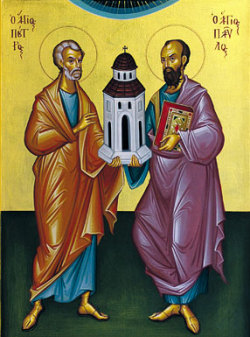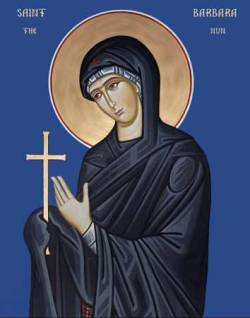

Orthodox Iconography can be an extremely concise way of communicating the Faith. Therefore, what the Saints hold in their hands in portrait icons help in identifying them and in telling us about their lives.
— Cross: It indicates the Saint is a Holy Martyr. The reason martyrs are shown holding a cross is two-fold: firstly, martyr comes for the Greek for witness, and so these witnesses hold the preeminent symbol of Christianity: the Cross. Secondly, the Cross symbolizes the most perfect sacrifice of life for others, Christ’s own crucifixion. Therefore, any Saints who were murdered for confessing the Faith are shown with crosses, regardless of how they died.
— Scroll: It indicates holy Wisdom, and so is often shown in the hands of the Old Testament prophets, but is also commonly seen in the hands of the Apostles. Both were given wisdom from God – the prophets through visions, the Apostles through meeting and knowing Jesus Christ. Later Saints may also be shown holding scrolls if they were also known for prophecy, percipience, and imparting divine knowledge to others.
— Gospel Book: Sainted Bishops in Icons hold their main tool: the Gospel Book, from which they proclaim the Good News to the faithful during the Liturgy. Many of the Church Fathers were also Bishops, and some of their “writings” which we read today were not writings at all, but sermons preached after the reading of the Gospel, later copied down by the congregation for other churches to benefit from. Their inspired teachings were grounded in the Gospel, and so they hold these books in Icons as the instruments through which God granted them sainthood. And they hold them with great reverence indeed, indicated by the way some Icons show the Bishops covering their bare hand with their vestments or stole.
— Crosier: Another role of the Bishop is that of a pastor, or shepherd, of Christ’s flock. This is symbolized by the Crosier, which in Orthodoxy doesn’t look the same as the “shepherd’s crook” held by bishops in the West. It is of a simpler design, usually in the shape of the Greek letter Tau, which symbolizes life, resurrection, or the Cross.
— Weapons: Often there are weapons in icons, such as lances, shields and swords. In the first few centuries of the Church, two types of martyr gained particular devotion among Christians: virgin-martyrs and soldier-martyrs.These martyr-soldiers (and they usually hold crosses too, in remembrance of their sacrifice) have through their confession of faith become “soldiers for Christ”.
— Church Building: Some Saints are depicted holding a Church Building in their hands, just like Ss Peter and Paul. This reflects the hymnography of the Church, where the two Apostles are praised as “pillars of the Church.” Not only were they pillars of the Church, but church-builders too, establishing Christian communities (churches) around the Mediterranean and Holy Lands. Later, other Saints are remembered for their “church-building” and so are depicted holding small churches or monasteries, often in profile, shown offering the church to Christ. It is quite common for Sainted kings and queens to be shown holding churches in this way, as they are honoured for their role as protector and benefactor of the Church within their lands.
http://agapienxristou.blogspot.ca/2012/10/the-meaning-of-objects-held-by-saints.html